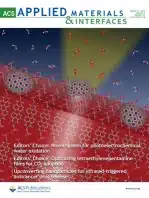
Shifeng Guo, Sreenivasa Reddy Puniredd, Dominik Jaczewski, Serina Siew Chen Lee, Serena Lay Ming Teo, Tao He, Xiaoying Zhu, and G. Julius Vansco
Abstract
Interaction forces of adhesive proteins employed by cyprid larvae of Amphibalanus amphitrite for temporary attachment during surface exploration in marine fouling were studied by AFM force spectroscopy using chemically modified, reactive colloidal probes. The proteins were covalently attached to the surfaces of the probes by incubation in the protein deposits (footprints) left behind at the surface by the cyprids. This covalent coupling enabled robust and reproducible probing of adhesion of the attachment proteins to model surfaces with variable hydrophilicity. Three model monolayer surfaces were designed and prepared that exhibited different wettabilities derived from variations in the monolayer chemical composition. The morphology and size of cyprid protein deposits was imaged by AFM. The deposits showed larger area of spreading on more hydrophobic surfaces, whereas the overall volume of the secreted proteins exhibited no significant variation. Notable difference in adhesion forces was found among the surfaces by force spectroscopy, with substantially higher values measured on the hydrophobic surface (21 ± 2 nN) than that measured on the more hydrophilic surface (7.2 ± 1 nN). The same surfaces were also tested in laboratory essays. Rather surprisingly, no significant differences were found in values of fractional cyprid settlement among the surfaces studied, indicating that variations of surface wettability and adhesion strength of settlement proteins may be insufficient to explain settlement trends.
https://pubs.acs.org/doi/10.1021/am503147m
Related Compounds
